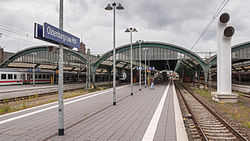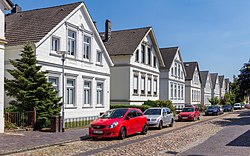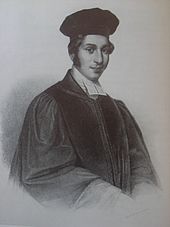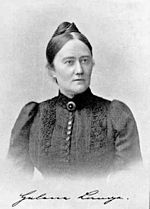world.wikisort.org - Germany
Oldenburg (German pronunciation: [ˈɔldn̩bʊʁk] (![]() listen)) is an independent city in the state of Lower Saxony, Germany. The city is officially named Oldenburg (Oldb) (Oldenburg in Oldenburg) to distinguish from Oldenburg in Holstein.
listen)) is an independent city in the state of Lower Saxony, Germany. The city is officially named Oldenburg (Oldb) (Oldenburg in Oldenburg) to distinguish from Oldenburg in Holstein.
This article has multiple issues. Please help improve it or discuss these issues on the talk page. (Learn how and when to remove these template messages)
|
Oldenburg | |
|---|---|
City | |
 City centre of Oldenburg including St Lamberti Church, Schloss Oldenburg (Oldenburg Palace) and the Oldenburgisches Staatstheater (Oldenburg State Theatre; left image border). | |
 Flag  Coat of arms | |
Location of Oldenburg (city)  | |
 Oldenburg  Oldenburg | |
| Coordinates: 53°08′38″N 8°12′50″E | |
| Country | Germany |
| State | Lower Saxony |
| District | Urban district |
| Subdivisions | 33 boroughs, separated into nine census tracts |
| Government | |
| • Lord mayor (2021–26) | Jürgen Krogmann[1] (SPD) |
| Area | |
| • Total | 102.96 km2 (39.75 sq mi) |
| Elevation | 4 m (13 ft) |
| Population (2020-12-31)[2] | |
| • Total | 169,605 |
| • Density | 1,600/km2 (4,300/sq mi) |
| Time zone | UTC+01:00 (CET) |
| • Summer (DST) | UTC+02:00 (CEST) |
| Postal codes | 26001–26135 |
| Dialling codes | 0441 |
| Vehicle registration | OL |
| Website | www |
During the French annexation (1811–1813) in the wake of the Napoleonic war against Britain, it was also known as Le Vieux-Bourg in French. The city is at the rivers Hunte and Haaren, in the northwestern region between the cities of Bremen in the east and Groningen (Netherlands) in the west. It has a population of 170,000 (November 2019).[3] Oldenburg is part of the Bremen/Oldenburg Metropolitan Region, with 2.37 million people.
The city is the place of origin of the House of Oldenburg. Before the end of the German Empire (1918), it was the administrative centre and residence of the monarchs of Oldenburg.
History
Archaeological finds point to a settlement dating back to the 8th century. The first documentary evidence, in 1108, referenced Aldenburg in connection with Elimar I (also known as Egilmar I) who is now commonly seen as the first count of Oldenburg. The town gained importance due to its location at a ford of the navigable Hunte river. Oldenburg became the capital of the County of Oldenburg (later a Duchy (1774- 1810), Grand Duchy (1815–1918), and Free State (1918–1946)), a small state in the shadow of the much more powerful Hanseatic city of Bremen.[4]
In the 17th century Oldenburg was a wealthy town in a time of war and turmoil and its population and power grew considerably. In 1667, the town was struck by a disastrous plague epidemic and, shortly after, a fire destroyed Oldenburg. The Danish kings, who were also counts of Oldenburg at the time, had little interest in the condition of the town and it lost most of its former importance. In 1773, Danish rule ended. Only then were the destroyed buildings in the city rebuilt in a neoclassicist style.[4] (German-speakers usually call the "neoclassicist style" of that period klassizistisch, while neoklassizistisch specifically refers to the classicist style of the early 20th century.)

After the German government announced the abdication of Emperor Wilhelm II (9 November 1918) following the exhaustion and defeat of the German Empire in World War I, monarchic rule ended in Oldenburg as well with the abdication of Grand Duke Frederick Augustus II of Oldenburg (Friedrich August II von Oldenburg) on 11 November 1918. The Grand Duchy now became the Free State of Oldenburg (German: Freistaat Oldenburg), with the city remaining the capital.
In the 1928 city elections, the Nazi Party received 9.8% of the vote, enough for a seat on the Oldenburg city council. In the September 1930 Oldenburg state elections, the Nazi Party's share of the vote rose to 27.3%, and on May 29, 1932, the Nazi Party received 48.4% in the state election, enough to put the Nazi party in charge of forming a state government and, significantly, making Oldenburg the first state in the country to put the Nazis in power based on electoral turnout. By that autumn, a campaign of Aryanization began, forcing the sale of formerly Jewish-owned properties at steep discounts.[5]
In 1945, after World War II, the State of Oldenburg became part of the British zone of occupation. The British military government of the Oldenburg region resided in the city. Several displaced-persons camps were set up in the city that had suffered only 1.4% destruction during the bombing campaigns of World War II.[6] About 42,000 refugees migrated into Oldenburg, which raised the number of residents to over 100,000. In 1946 the Free State of Oldenburg was dissolved and the area became the 'Administrative District' of Oldenburg (Verwaltungsbezirk Oldenburg) within the newly formed federal German state of Lower Saxony (Niedersachsen). The city was now capital of the district. In 1978 the district was dissolved and succeeded by the newly formed Weser-Ems administrative region (Regierungsbezirk Weser-Ems), again with the city as administrative capital. The state of Lower Saxony dissolved all of the Regierungsbezirke by the end of 2004 in the course of administrative reforms.
City government
Local elections take place every five years. The city council (Stadtrat) has 50 seats. The lord mayor (Oberbürgermeister) is elected directly by the citizens.
| Election year |
SPD | Bündnis ’90/ Die Grünen |
CDU | Die Linke | Freie Wähler/ FW-BFO |
FDP | Piraten Partei |
NPD | LKR | AFD |
|---|---|---|---|---|---|---|---|---|---|---|
| 2001 | 40.1 | 13.6 | 30.5 | 3.9 | 2.8 | 8.2 | – | – | – | – |
| 2006 | 32.7 | 21.2 | 26.0 | 7.2 | 5.4 | 6.3 | – | – | – | – |
| 2011 | 34.0 | 27.3 | 20.6 | 6.1 | 3.1 | 3.0 | 2.8 | 1.1 | – | – |
| 2016 | 32.68 | 19.13 | 22.21 | 9.88 | 1.53 | 4.84 | 1.17 | 0.62 | 1.19 | 4.76 |
| Election year |
SPD | Grüne | CDU | Linke | FW | FDP | Piraten | WFO | NPD | LKR | AFD | Total seats |
|---|---|---|---|---|---|---|---|---|---|---|---|---|
| 2001 | 21 | 7 | 15 | 2 | 1 | 4 | – | – | – | – | – | 50 |
| 2006 | 16 | 11 | 13 | 4 | 3 | 3 | – | – | – | – | – | 50 |
| 2011 | 17 | 14 | 10 | 3 | 2 | 1 | 1 | 1 | 1 | – | – | 50 |
| 2016 | 16 | 10 | 11 | 5 | 1 | 2 | 1 | 1 | 0 | 1 | 2 | 50 |
Economy and infrastructure
Transport


The city centre of Oldenburg is surrounded by a ring of freeways (autobahns) consisting of A 28, A 29 and A 293. Because of this, Oldenburg is connected to the nationwide network of federal autobahns, as well as to the international E-road network (German: Europastraßen).
Oldenburg Central Station, Oldenburg (Oldb) Hauptbahnhof, is at the intersection of the railway lines Norddeich Mole—Leer—Oldenburg—Bremen and Wilhelmshaven—Oldenburg—Osnabrück, with Intercity services to Berlin, Leipzig and Dresden and InterCityExpress services to Frankfurt and Munich.
Oldenburg is only about half an hour drive from Bremen Airport (about 50 km | 31 miles). Other international airports nearby are Hamburg Airport (160 km | 100 miles) and Hannover-Langenhagen Airport (170 km | 106 miles).
The small Hatten Airfield, (Flugplatz Oldenburg-Hatten ICAO airport code: EDWH), is located about 17 km south-west of Oldenburg. It serves to small aircraft (private planes, gliders, balloons, and helicopters). A flight training school is also located there, and small planes can be chartered. Scenic flights can be booked as well.
Oldenburg is connected to shipping through the Küstenkanal, a ship canal connecting the rivers Ems and Weser. With 1.6 million tons of goods annually, it is the most important non-coastal harbour in Lower Saxony.
Bicycles play a very important part in personal transport.
Agriculture
The city is surrounded by large agricultural areas, about 80% of which is grassland. There are farms near and even a few within city limits. Predominant agricultural activities of the region are the cultivation of livestock, especially dairy cows and other grazing animals, crops such as grains for food and animal feed, as well as asparagus, corn, and kale.
Industry
Sea salt production in the Oldenburg region has been used since the 15th century to supply the huge salt demand in the Baltic region. Peat extraction in the area continued for many centuries until it was replaced by coal mines.
Demographics
| Residents by foreign citizenship[8] | |
| Nationality | Population (2020) |
|---|---|
| 3,635 | |
| 2,190 | |
| 1,425 | |
| 1,275 | |
| 1,135 | |
| 550 | |
| 450 | |
| 445 | |
| 410 | |
As of 31.12.2019 Oldenburg had 169,960 residents. 24.8% of the population were first or second generation immigrants.[9]
Cultural life

Recurring cultural events
- Kultursommer (summer of culture), series of free musical and other cultural events in the city centre during summer holiday season in July.
- CSD Nordwest (Christopher Street Day) parade of the regional Lesbian, Gay, Bisexual, Transgender community in June, with up to 10,000 participants (since 1995).
- Stadtfest, a three-day festival of the city centre in August/September, comprises gastronomical offerings and rock and pop music performances on various stages.
- Oldenburg International Film Festival, privately organised film festival in September, focussed on independent film and film makers. The festival is funded through public subsidies and private sponsoring.
- Kramermarkt, fun fair at the Weser-Ems Halle on ten days in September/October. The tradition of this annual volksfest dates back to the 17th century, when the Kramermarkt was a market event at the end of the harvest.
- Oldenburger Kinder- und Jugendbuchmesse (KIBUM), an exhibition of new German language children's and youth literature, takes place over 11 days in November. A non-commercial fair organised by the city government in cooperation with the public library and the university library. In the course of the fair, a prize, the Kinder- und Jugendbuchpreis, is awarded to a debuting author or illustrator.
Points of interest
- Core city centre, large pedestrianized shopping destination for the region.
- Oldenburg State Theatre, oldest mainstream theatre in Oldenburg, first opened in 1833.
- Schloss Oldenburg in the city centre, until 1918 residence of the monarchic rulers of Oldenburg, today a museum. A public park, the Schlossgarten, is nearby.
- Weser-Ems Halle, exhibition and congress centre with outdoor fair area, located in Oldenburg Donnerschwee.
- Small EWE Arena and Large EWE Arena, two sports and event halls located near the main railway station, opened in 2005 and 2013, and seating up to 4,000 and 6,852 visitors respectively. The large arena is also home to the EWE Baskets Oldenburg basketball club.
Lutheran community
Oldenburg is the seat of administration and bishop of the Evangelical Lutheran Church in Oldenburg, whose preaching venue is the St Lamberti Church.
Jewish community

The history of the Jewish community of Oldenburg dates back to the 14th century.[10] Towards and during the 19th century, the Jews in Oldenburg were always around 1% of the total population, and by that time had acquired their own synagogue, cemetery and school. Most of them were merchants and businessmen. On 1938 Kristallnacht, the town men were led to Sachsenhausen concentration camp, among them Leo Trepp, the community Rabbi who survived and later became an honorary citizen of Oldenburg and honored by a street named after him.[11] Since 1981 an annual commemoration walk (Erinnerungsgang) has been held by Oldenburg citizens in memory of the deportation of the Oldenburg Jews on November 10, 1938.[12] Those who remained after 1938 emigrated to Canada, USA, United Kingdom, Holland or Mandatory Palestine.
After World War II, a group of survivors returned to the city and maintained a small community until it was dissolved during the 1970s. Nevertheless, due to Jewish emigration from the former USSR to Germany in the 1990s, a community of about 340 people is now maintaining its own synagogue, cemetery and other facilities. The old Jewish cemetery, which is no longer active after the opening of a new one, was desecrated twice in 2011 and 2013.[13]
Media
- Nordwest-Zeitung (NWZ) Oldenburg-based daily newspaper, also provides local editions in neighbouring counties
- Free weekly newspapers delivered to households, mainly for ads and inserts: Hunte-Report (Wednesdays+Sundays), Sonntagszeitung (Sundays).
- Diabolo free weekly city magazine / listings magazine
- Mox free biweekly event listings magazine (from the same publisher as Diabolo)
- Alhambra-Zeitung bimonthly leftist, anti-fascist magazine
- Oldenburger Stachel local alternative magazine (discontinued)
- Oldenburgische Wirtschaft monthly magazine of the Oldenburg Chamber of Industry and Commerce (Industrie- und Handelskammer)
Radio and television
- Oldenburg Eins non-commercial public-access cable TV and radio station (live streams available online)
- Norddeutscher Rundfunk (NDR), public TV and radio broadcaster (part of the ARD), maintains a regional studio in Oldenburg.
- Radio FFN, commercial radio broadcaster, maintains a regional studio located in the NWZ building.
Online
- Nordwest-Zeitung TV Local video news clips published by the Nordwest-Zeitung
Education
Tertiary education
There are two public universities in Oldenburg:
- The Carl von Ossietzky University of Oldenburg was founded in 1973 based on a previous college for teacher training, the Pädagogische Hochschule Oldenburg, which had a history in Oldenburg dating back to 1793. The university was officially named after Carl von Ossietzky in 1991. As of 2014, it has almost 13,746 students, a scientific staff of 1,130, as well as 964 technical and administrative staff.[14] A new faculty of medicine and health sciences was established in 2012 as part of the newly founded European Medical School Oldenburg-Groningen, a cooperation with the University of Groningen (Netherlands) and local hospitals.[15]
- The Jade University of Applied Sciences (Jade-Hochschule) The former Fachhochschule Oldenburg (until 1999) was founded in 1971, a merger of the previous engineering academy with the nautical college in Elsfleth. Oldenburg already had a history of construction engineering training dating back to 1882. Starting in 2000, the Fachhochschule had been part of multiple re-organisations involving several UAS (Fachhochschule) in the northwestern region. A relaunch under the name Jade-Hochschule took place in 2009 (previously: Fachhochschule Oldenburg/Ostfriesland/Wilhelmshaven). The Jade-Hochschule now comprises branches in three towns: Oldenburg, Elsfleth, and Wilhelmshaven. Based in Oldenburg are the departments of architecture, construction engineering and construction management, geodesy, as well as the institute of hearing aid technology and audiology. There are about 2,000 students in the Oldenburg branch.[16] (The Elsfleth branch offers bachelor's degree courses in nautical science, international logistics, and harbour management. The Wilhelmshaven branch offers courses in engineering, business management, and media management.)
Privately managed institutions of higher education:
- Founded in 2004, the IBS IT & Business School Oldenburg (former Berufsakademie Oldenburg), a college of cooperative education, offers a B.Sc. degree course in business informatics and a B.A. degree course in business studies. The dual-system course combines practical vocational training at one of the partnering local companies with periods of academic studies.
- The Private Fachhochschule für Wirtschaft und Technik, a regional college of cooperative education, maintains a branch in Oldenburg offering bachelor's degree courses with integrated vocational training in electrical engineering and mechatronics.
Other:
- The Oldenburg branch of the Lower Saxony police academy (Polizeiakademie Niedersachsen) maintains a study facility in Oldenburg preparing candidates for a career in higher-middle-level or higher-level police service.
Primary and secondary education
- Gymnasium Graf-Anton-Guenther School
- Wirtschaftsgymnasium Oldenburg
- Cäcilienschule Oldenburg
- Liebfrauenschule Oldenburg
- Herbartgymnasium Oldenburg
- Altes Gymnasium Oldenburg
- Neues Gymnasium Oldenburg
- Gymnasium Eversten
- IGS Flötenteich
- Helene Lange Schule Oldenburg (IGS)
- Realschule Hochheider Weg
- Real- und Hauptschule Osternburg
- Realschule Ofenerdiek
- Kath. Grundschule Lerigauweg
Sports
Oldenburg hosted the 2007 Fistball World Championship.
It has two football teams, VfB Oldenburg and VfL Oldenburg, who also have a handball section of the same name.
Moreover, Oldenburg is home to the basketball team EWE Baskets Oldenburg.
Twin towns – sister cities
Oldenburg is twinned with:[17]
 Høje-Taastrup, Denmark (1978)
Høje-Taastrup, Denmark (1978) Cholet, France (1985)
Cholet, France (1985) Groningen, Netherlands (1989)
Groningen, Netherlands (1989) Makhachkala, Russia (1989)
Makhachkala, Russia (1989) Rügen (district), Germany (1990)
Rügen (district), Germany (1990) Mateh Asher, Israel (1996)
Mateh Asher, Israel (1996) Kingston upon Thames, England, United Kingdom (2010)
Kingston upon Thames, England, United Kingdom (2010) Buffalo City, South Africa (2012)
Buffalo City, South Africa (2012) Qingdao, China (2014)
Qingdao, China (2014) Xi'an, China (2017)
Xi'an, China (2017)
Notable people



- Christian I of Denmark (1426–1481), King of Denmark
- John V, Count of Oldenburg (1460–1526), Count of Oldenburg
- Martin Zaagmolen (? –c.1669), Dutch painter
- Friedrich Karl Hermann Kruse (1790–1866), historian
- Sophie Löwe (1815–1866), opera soprano
- Isaac Friedlander (1823–1878), American wheat broker and California land speculator
- Reinhard Schlichting (1835–1897), American manufacturer and politician in Wisconsin
- Helene Lange (1848–1930), politician, educator and suffragist
- Diedrich A. W. Rulfs (1848-1926), Architect
- August Dinklage (1849–1920), architect and buildings official
- August Brauer (1863–1917), zoologist
- Rudolf Heinze (1865–1928), jurist and politician
- Karl Jaspers (1883–1969), philosopher and writer
- Otto Schultze (1884–1966), Generaladmiral with the Kriegsmarine during World War II
- Otto Suhr (1894–1957), politician
- Wilhelm Gideon (1898–1977), Nazi SS commandant of the Gross-Rosen concentration camp
- Hermann Behrends (1907–1948), Nazi SS officer executed for war crimes
- Hans Günther Aach (1919–1999), botanist
- Heinz Rökker (1920–2018), WWII fighter pilot
- Jürgen Goslar (born 1927), actor and director
- Ulrike Meinhof (1934–1976), journalist, far-left activist and co-founder of the Red Army Faction
- Brigitte Boehme (born 1940), lawyer and church administrator
- Thomas Schmidt-Kowalski (1949–2013), composer
- Manfred Milinski (born 1950), biologist and member of the Max Planck Institute
- Stefan Czapsky (born 1950), American cinematographer
- Klaus Modick (born 1951), author and literary translator
- Rena Niehaus (born 1954), film actress
- Thomas Schütte (born 1954), sculptor and draftsman
- Heiko Daxl (1957–2012), media artist and curator
- Andrea Clausen (born 1959), stage actress, member of the Burgtheater ensemble
- Bernd Althusmann (born 1966), politician (CDU)
- Thyra von Westernhagen (born 1973), Hanoverian princess by marriage
- Hasnain Kazim (born 1974), journalist
- Sarah Nemtsov (née Reuter, born 1980), composer
- Klaas Heufer-Umlauf (born 1983), host and actor
Sport
- Felix Gerritzen (1927–2007), footballer
- Karsten Baumann (born 1969), football player and manager
- Hans-Jörg Butt (born 1974), footballer
- Oliver Köhrmann (born 1976), handball player
- Johannes Bitter (born 1982), handball player, goalie of the German international team
Associated with Oldenburg

See in particular the Counts, Dukes and Grand Dukes of Oldenburg for the rulers who were not born in Oldenburg.
- Arp Schnitger (1648–1719), organ builder
- Princess Cecilia of Sweden (1807–1844) (1807–1844), Princess of Sweden
- Wilhelm Heinrich Schüßler (1821–1898), medical doctor and naturopath
- Lothar Meyer (1830–1895), chemist, studied here
- Peter Suhrkamp (1891–1959), founder of the Suhrkamp-Verlag
- Hermann Ehlers (1904–1954), politician (CDU), President of the German Bundestag, was at the beginning of his political career a landlord in Oldenburg
- Erna Schlüter (1904–1969), operatic dramatic soprano
See also
- Route of Megalithic Culture – tourist route from Osnabrück to Oldenburg via some 33 Megalithic sites.
References
- "Stichwahlen zu Direktwahlen in Niedersachsen vom 26. September 2021" (PDF). Landesamt für Statistik Niedersachsen. 13 October 2021. Archived (PDF) from the original on 2022-10-09.
- Landesamt für Statistik Niedersachsen, LSN-Online Regionaldatenbank, Tabelle A100001G: Fortschreibung des Bevölkerungsstandes, Stand 31. Dezember 2020.
- "Einwohnerzahl steigt". Archived from the original on 2019-11-06. Retrieved 2019-11-06.
- One or more of the preceding sentences incorporates text from a publication now in the public domain: Chisholm, Hugh, ed. (1911). "Oldenburg". Encyclopædia Britannica. Vol. 20 (11th ed.). Cambridge University Press. p. 72.
- Goldsmith, Martin (2014). Alex's Wake: A Voyage of Betrayal and a Journey of Remembrance. Da Capo Press. pp. 44–46. ISBN 978-0306823220.
- Ulrich Schneider: Niedersachsen 1945, p. 95. Hannover 1985
- Source: Official results of elections published on the official website of the city of Oldenburg.
- "Ausländer nach Nationalität 2014 bis 2020" (PDF). Archived (PDF) from the original on 2022-10-09. Retrieved 29 August 2021.
- "Archived copy" (PDF). Archived from the original (PDF) on 2021-08-29. Retrieved 2021-08-29.
{{cite web}}: CS1 maint: archived copy as title (link) - "OLDENBURG - JewishEncyclopedia.com". www.jewishencyclopedia.com. Archived from the original on 22 June 2017. Retrieved 29 April 2018.
- Oldenburg, Stadt. "1990: Prof. Dr. Dr. h.c. Leo Trepp – Stadt Oldenburg". www.oldenburg.de. Retrieved 29 April 2018.
- "Erinnerungsgang -". Erinnerungsgang. Archived from the original on 24 October 2017. Retrieved 29 April 2018.
- "Антисемиты осквернили еврейское кладбище в Ольденбурге » Центральный Еврейский Ресурс SEM40. Израиль, Ближний восток, евреи". Archived from the original on 2015-04-02. Retrieved 2015-03-22.
- "Statistics published on the CvO University's web site, retrieved in 2014". uni-oldenburg.de. Archived from the original on 2 July 2016. Retrieved 29 April 2018.
- "VI. School of Medicine and Health Sciences". uni-oldenburg.de. 25 April 2018. Archived from the original on 12 October 2017. Retrieved 29 April 2018.
- "Statistics published on the Jade-Hochschule website, retrieved in January 2012". jade-hs.de. Archived from the original on 4 August 2010. Retrieved 29 April 2018.
- "Oldenburgs Partnerkommunen". oldenburg.de (in German). Oldenburg. Retrieved 2022-08-23.
External links
- Official website
- Official Oldenburg tourist information centre
- Oldenburg Panoramas 360-degree panning views
- Straßen von Oldenburg Drive-through videos of Oldenburg streets (in German)
- Alt Oldenburg Large collection of historical photographs of Oldenburg (in German)
- Oldenburg Association for Family Research e.V. genealogy of emigrants from Oldenburg
- Oldenburgische Landschaft (in German), Oldenburg-based public body of municipalities within the area of the former State of Oldenburg
На других языках
[de] Oldenburg (Oldb)
Oldenburg (niederdeutsch Ollnborg, saterfriesisch Ooldenbuurich) ist eine kreisfreie Stadt in Niedersachsen. Die Gemeinde führt die amtliche Bezeichnung Oldenburg (Oldb) als Abkürzung von „Oldenburg in Oldenburg“ in Abgrenzung zu Oldenburg in Holstein.[2]- [en] Oldenburg (city)
[es] Oldemburgo
Oldemburgo (pronunciación en alemán: /ˈɔldn̩bʊʁk/ ( escuchar); en alemán, Oldenburg; en bajo alemán, Ollnborg; en frisón de Saterland, Ooldenbuurich) es una ciudad independiente del estado de Baja Sajonia, en Alemania. Se llama oficialmente Oldenburg (Oldb) (Oldenburg in Oldenburg) para distinguirla de Oldenburg in Holstein.[ru] Ольденбург
О́льденбург (нем. Oldenburg, н.-нем. Ollnborg) — третий, по количеству населения, город немецкой федеральной земли Нижняя Саксония, находящейся на северо-западе Германии. Расположен на судоходной реке Хунте, соединённой Кюстен-каналом с рекой Эмс и впадающей в реку Везер. Официально город называется Oldenburg (Oldb), что значит Oldenburg in Oldenburg [7] и указывает на расположение города Ольденбурга на территории исторического, одноимённого государства, столицей которого город Ольденбург был вплоть до начала 20 века.Другой контент может иметь иную лицензию. Перед использованием материалов сайта WikiSort.org внимательно изучите правила лицензирования конкретных элементов наполнения сайта.
WikiSort.org - проект по пересортировке и дополнению контента Википедии